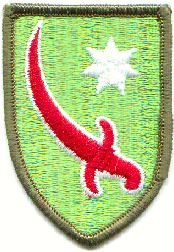In 1943 when General Connolly was chosen to head this overseas contingent, he asked the heraldic experts in the office of the Quartermaster General to whip up something tasty to distinguish the soldiers of his new command. Several ideas were beaten out, the General and his staff thought them all a shade off. As a result the staff combined to design the new insignia, a shield of vivid green ornamented with a crimson saber, outlined in white, and a white seven pointed star. The three colors appear in the flags of both Iraq and Iran, scene of American activity in this corridor to Russia, and the star appears in the flag of Iraq. The saber, common to this part of the world, signifies that this is a combat outfit when and if the occasion presents itself.
Green is not only the family color of Mohammed, but signified as well the fertility once current in Iraq, particularly in the area between the Tigris and Euphrates rivers where the Garden of Eden is reputed to have been.
White entered the picture when, after the death of the prophet a schism among his followers caused an off-shoot to adopt the color as it's official emblem. It is here, as in most parts of the world, the symbol of purity. A later revolt within the Moslem ranks resulted in the formation of the Alhambrian Caliphate which adopted red as it's color, both in token of Islam's conquest and the blood shed in them.

